Ask A Researcher
October 2015
A Look at the Youngest North Dakotans
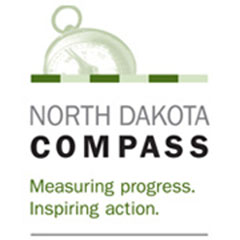
The North Dakota Compass website sets a standard for unbiased, up-to-date, and credible data and information. Moreover, by presenting data in a variety of topics that define quality of life, it provides a broader picture and can offer solutions to complex issues. In this article, the North Dakota Compass team highlights a variety of data trends and information associated with the young child population in North Dakota. Understanding trends helps us plan and improve child development, learning, and services for our communities and our state. The more we know about our children, the better equipped we are to make smart investments in the state’s future.
In 2014, there were 191,571 children younger than 20 years old in North Dakota, a 4% growth since 2000. The youngest children, ages 0 to 4, had the largest growth rate of all children and youth since 2000, increasing by 29% to 51,016 in 2014. This age group experienced a constant growth since 2004 not only in total numbers but also as a percentage of the total population.
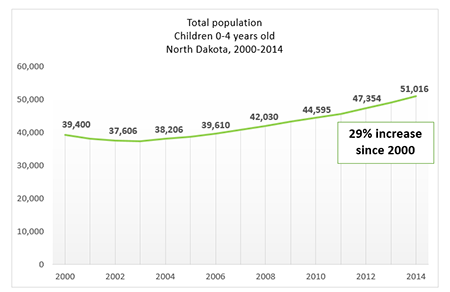
The growth of the number of children ages 0 to 4 is due in part to the migration of young workers into the state as a result of North Dakota’s flourishing economy. The growth of the young population who are of child-bearing age contributed to the already increasing trend in the number of births, resulting in 11,352 babies born in North Dakota in 2014.
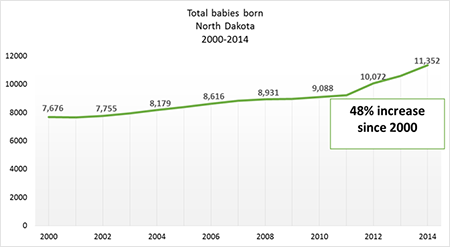
Beyond seeing a younger demographic migrating into the state, North Dakota communities are becoming more racially diverse. The increasing diversity is the most concentrated in the youngest age group, the 0 to 4 year olds, where one in five are persons of color (non-white).
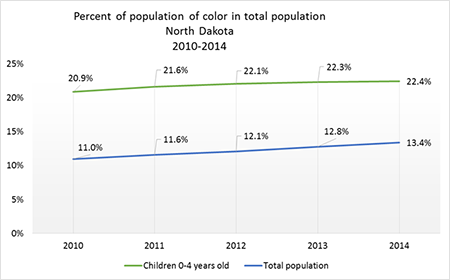
The robust economy in North Dakota has led to an increasing number of jobs and a low unemployment rate. North Dakota ranks fourth highest in the U.S. in terms of the proportion of adults working, with 77 percent of the adult population (age 16-64) in the workforce. This means that most parents of children are working. Specifically, 70 percent of children under 6 years old live in families where all the parents in the household work, which contributes to the financial stability and well-being of families with children. When all parents in the household are working, access to quality child care becomes an important consideration and possible necessity for families.
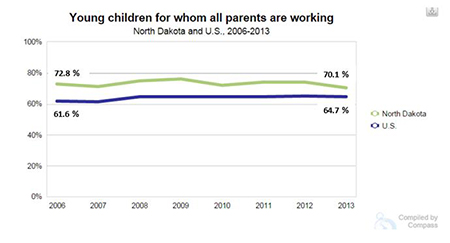
In addition, high quality preschool programs for 3 and 4 year old children play an important role in preparing children for success in school and life. In North Dakota, only 39 percent of children were enrolled in preschool programs (i.e., programs offering educational experiences for children during the years preceding kindergarten – including Head Start) in 2013, ranking North Dakota in the bottom 10 states for preschool opportunities.
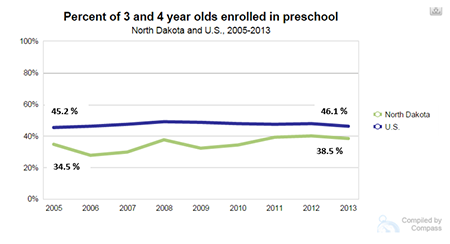
Quality early education programs produce quality outcomes for children and society. Children whose families are in poverty do not receive the same advantages in life as their peers who come from more affluent families (e.g., better quality childcare and education). Unfortunately, these disadvantages start to compound early in life and tend to make it more difficult to succeed. In North Dakota, the proportion of 3 and 4 year old children enrolled in preschool is somewhat lower for children below the poverty level (33%) than for children above the poverty level (38%). Programs, such as Head Start and Early Head Start, are available to help low-income families with young children support the mental, social, and emotional development of children and also provide educational services to help children become ready for school.
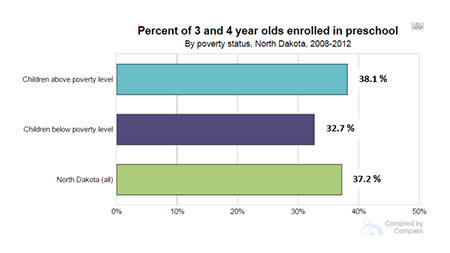
Understanding the demographic characteristics of this growing young child population is critical to know how to best support their healthy development and help lay the foundation for future successes. Offering various types of support to families, teachers, and caregivers of young children to encourage healthy physical, cognitive, social, and emotional development, will contribute to the improved quality of life in North Dakota.
